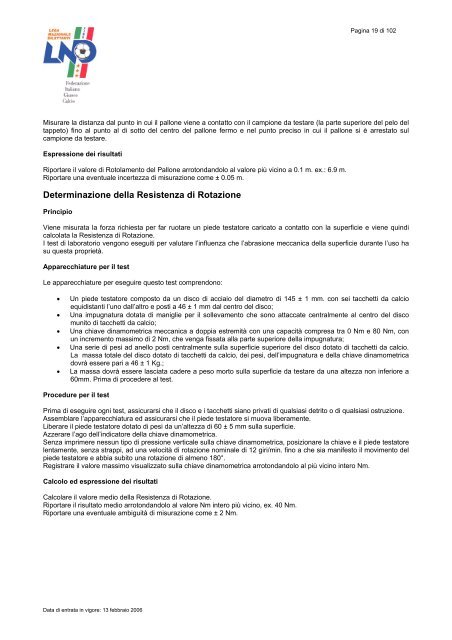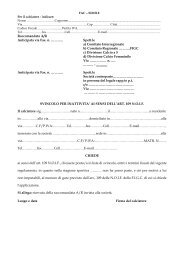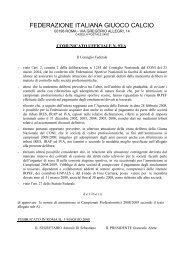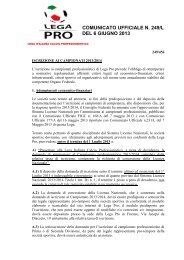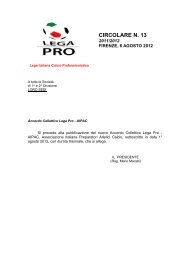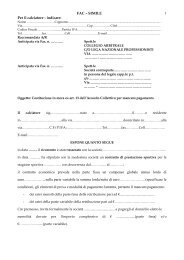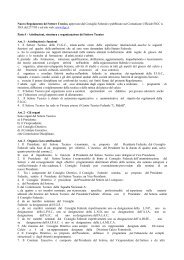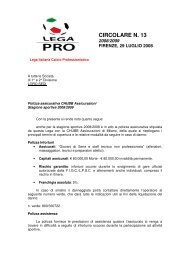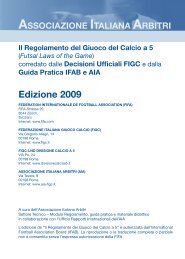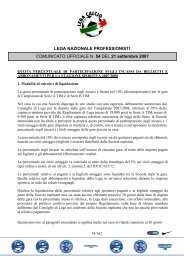LND Regolamento per la realzizzazione di un ... - Diritto Calcistico
LND Regolamento per la realzizzazione di un ... - Diritto Calcistico
LND Regolamento per la realzizzazione di un ... - Diritto Calcistico
You also want an ePaper? Increase the reach of your titles
YUMPU automatically turns print PDFs into web optimized ePapers that Google loves.
Data <strong>di</strong> entrata in vigore: 13 febbraio 2006<br />
Pagina 19 <strong>di</strong> 102<br />
Misurare <strong>la</strong> <strong>di</strong>stanza dal p<strong>un</strong>to in cui il pallone viene a contatto con il campione da testare (<strong>la</strong> parte su<strong>per</strong>iore del pelo del<br />
tappeto) fino al p<strong>un</strong>to al <strong>di</strong> sotto del centro del pallone fermo e nel p<strong>un</strong>to preciso in cui il pallone si è arrestato sul<br />
campione da testare.<br />
Espressione dei risultati<br />
Riportare il valore <strong>di</strong> Roto<strong>la</strong>mento del Pallone arrotondandolo al valore più vicino a 0.1 m. ex.: 6.9 m.<br />
Riportare <strong>un</strong>a eventuale incertezza <strong>di</strong> misurazione come ± 0.05 m.<br />
Determinazione del<strong>la</strong> Resistenza <strong>di</strong> Rotazione<br />
Principio<br />
Viene misurata <strong>la</strong> forza richiesta <strong>per</strong> far ruotare <strong>un</strong> piede testatore caricato a contatto con <strong>la</strong> su<strong>per</strong>ficie e viene quin<strong>di</strong><br />
calco<strong>la</strong>ta <strong>la</strong> Resistenza <strong>di</strong> Rotazione.<br />
I test <strong>di</strong> <strong>la</strong>boratorio vengono eseguiti <strong>per</strong> valutare l’influenza che l’abrasione meccanica del<strong>la</strong> su<strong>per</strong>ficie durante l’uso ha<br />
su questa proprietà.<br />
Apparecchiature <strong>per</strong> il test<br />
Le apparecchiature <strong>per</strong> eseguire questo test comprendono:<br />
• Un piede testatore composto da <strong>un</strong> <strong>di</strong>sco <strong>di</strong> acciaio del <strong>di</strong>ametro <strong>di</strong> 145 ± 1 mm. con sei tacchetti da calcio<br />
equi<strong>di</strong>stanti l’<strong>un</strong>o dall’altro e posti a 46 ± 1 mm dal centro del <strong>di</strong>sco;<br />
• Una impugnatura dotata <strong>di</strong> maniglie <strong>per</strong> il sollevamento che sono attaccate centralmente al centro del <strong>di</strong>sco<br />
m<strong>un</strong>ito <strong>di</strong> tacchetti da calcio;<br />
• Una chiave <strong>di</strong>namometrica meccanica a doppia estremità con <strong>un</strong>a capacità compresa tra 0 Nm e 80 Nm, con<br />
<strong>un</strong> incremento massimo <strong>di</strong> 2 Nm, che venga fissata al<strong>la</strong> parte su<strong>per</strong>iore del<strong>la</strong> impugnatura;<br />
• Una serie <strong>di</strong> pesi ad anello posti centralmente sul<strong>la</strong> su<strong>per</strong>ficie su<strong>per</strong>iore del <strong>di</strong>sco dotato <strong>di</strong> tacchetti da calcio.<br />
La massa totale del <strong>di</strong>sco dotato <strong>di</strong> tacchetti da calcio, dei pesi, dell’impugnatura e del<strong>la</strong> chiave <strong>di</strong>namometrica<br />
dovrà essere pari a 46 ± 1 Kg.;<br />
• La massa dovrà essere <strong>la</strong>sciata cadere a peso morto sul<strong>la</strong> su<strong>per</strong>ficie da testare da <strong>un</strong>a altezza non inferiore a<br />
60mm. Prima <strong>di</strong> procedere al test.<br />
Procedure <strong>per</strong> il test<br />
Prima <strong>di</strong> eseguire ogni test, assicurarsi che il <strong>di</strong>sco e i tacchetti siano privati <strong>di</strong> qualsiasi detrito o <strong>di</strong> qualsiasi ostruzione.<br />
Assemb<strong>la</strong>re l’apparecchiatura ed assicurarsi che il piede testatore si muova liberamente.<br />
Liberare il piede testatore dotato <strong>di</strong> pesi da <strong>un</strong>’altezza <strong>di</strong> 60 ± 5 mm sul<strong>la</strong> su<strong>per</strong>ficie.<br />
Azzerare l’ago dell’in<strong>di</strong>catore del<strong>la</strong> chiave <strong>di</strong>namometrica.<br />
Senza imprimere ness<strong>un</strong> tipo <strong>di</strong> pressione verticale sul<strong>la</strong> chiave <strong>di</strong>namometrica, posizionare <strong>la</strong> chiave e il piede testatore<br />
lentamente, senza strappi, ad <strong>un</strong>a velocità <strong>di</strong> rotazione nominale <strong>di</strong> 12 giri/min. fino a che sia manifesto il movimento del<br />
piede testatore e abbia subito <strong>un</strong>a rotazione <strong>di</strong> almeno 180°.<br />
Registrare il valore massimo visualizzato sul<strong>la</strong> chiave <strong>di</strong>namometrica arrotondandolo al più vicino intero Nm.<br />
Calcolo ed espressione dei risultati<br />
Calco<strong>la</strong>re il valore me<strong>di</strong>o del<strong>la</strong> Resistenza <strong>di</strong> Rotazione.<br />
Riportare il risultato me<strong>di</strong>o arrotondandolo al valore Nm intero più vicino, ex. 40 Nm.<br />
Riportare <strong>un</strong>a eventuale ambiguità <strong>di</strong> misurazione come ± 2 Nm.


